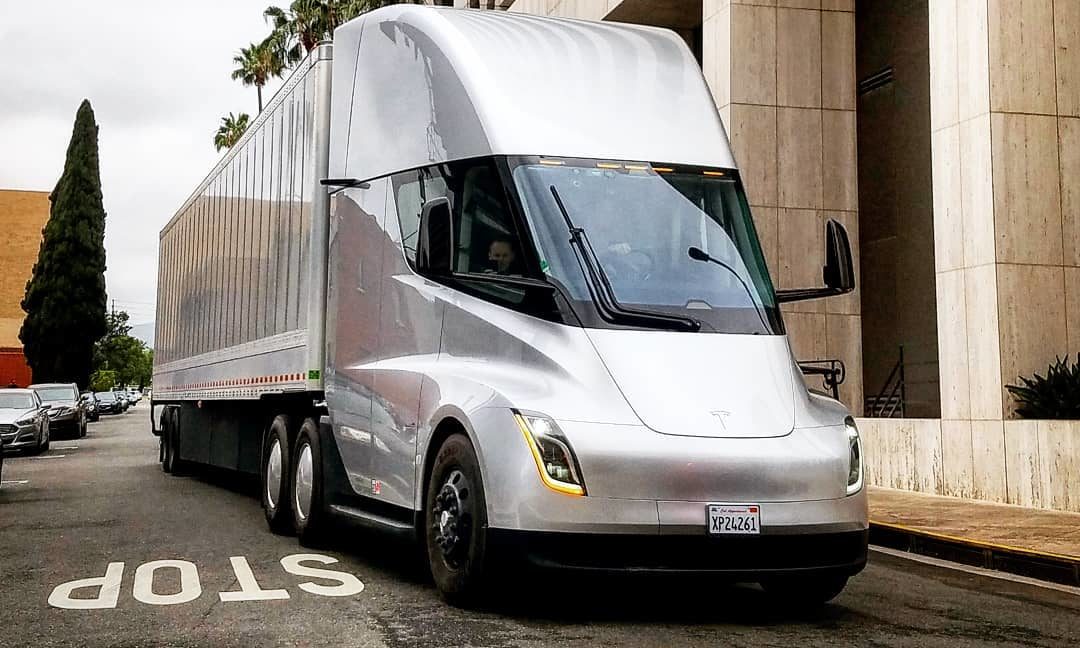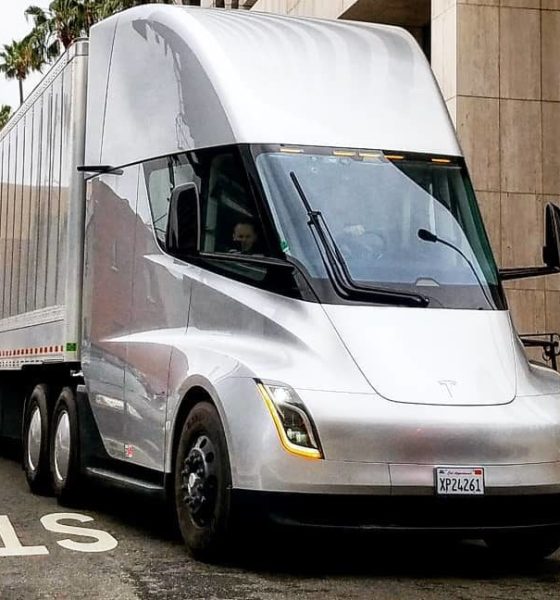The Tesla Semi was recently spotted near one of the company’s most historic locations — the West Los Angeles Service Center — a site where Elon Musk famously met with early reservation holders of the Tesla Roadster at a time when the company was on the verge of bankruptcy.
According to Mirk_idk, an auto enthusiast on Instagram, he spotted the Tesla Semi just as it was leaving Santa Monica Blvd., the same street as Tesla’s LA Service Center, on May 24 at around 10:30 a.m. local time. The auto enthusiast noted that the Semi appeared to be accompanied by two Model S sedans. There were also two people in the electric long-hauler, one of whom acknowledged him as he snapped a photo of the vehicle.
Just like the Semi’s recent sighting in Sunnyvale, CA, the electric truck was hauling a trailer when it was photographed. Its rear wheels were also equipped with covers that are reminiscent of the Model 3’s Aero Wheels.
https://www.instagram.com/p/BjK5inOFv6S/?taken-by=mirks_idk
The Tesla Semi’s latest appearance is particularly noteworthy, considering that Los Angeles is the location of two important Tesla facilities — the LA Service Center and the Tesla Design Center. The Tesla Design Center, the facility where the Semi and the next-generation Roadster were designed, is just 13 miles away from the site of the recent sighting. The LA Service Center, on the other hand, has a more historical significance to the company.
Back in 2008, Tesla, together with Musk’s private space venture, SpaceX, were feeling the effects of a worsening economy. Both companies were a few steps away from folding, and Elon Musk was exhausting his options. Musk ultimately decided to raise the price of the original Roadster to help the company’s funds. The meeting with some of the Roadster’s reservation holders happened at the LA service center.
Part of the fateful meeting was featured in the documentary Revenge of the Electric Car, which featured Tesla during the development days of the Roadster. Musk later described the meeting as “very tough” and that there was anger from some people in the room.
“I cannot understate the degree of grief that I’ve personally gone through, and that many people in Tesla have gone through to make this work. I wish we didn’t have to waste prices. It sucks. I can’t carry Tesla entirely by myself. I just don’t have the resources do it. We can’t sell cars for less than they cost us to produce,” Musk said during the meeting.
As history would show, of course, Musk would eventually pull off the near-impossible after that meeting, ultimately saving both SpaceX and Tesla from going under. Tesla closed its much-needed financing round on Christmas Eve 2008. According to Musk during a Q&A session at the Paris-Sorbonne University in December 2015, the financing round concluded “on the last hour of the last day when it was possible.”
The Tesla Semi is a Class 8 electric truck that is capable of hauling up to 80,000 pounds of cargo. The vehicle is equipped with four Model 3-derived electric motors and is capable of sprinting from 0-60 mph in 5 seconds without any load. With a full 80,000-pound load, the long-hauler can hit highway speeds in 20 seconds. The Semi is expected to start production in 2019.
As the company prepares to begin the manufacture of the electric trucks, Tesla has started utilizing the vehicles for battery pack deliveries between Gigafactory 1 in Sparks, NV to the Fremont CA facility. Multiple sightings of the trucks in the middle of their transport runs have been reported since then.
The Semi has also been spotted on the site of some of its biggest buyers. Earlier this year, the electric truck was sighted in the Anheuser-Busch Brewery in St. Louis, MO. It also made an appearance in Dallas, TX, where it was demoed for PepsiCo employees. The black matte Tesla Semi was sighted on the back of a truck at a highway near Des Moines, IA as well, close to the headquarters of Ruan Transportation Management Systems.

Elon Musk
Elon Musk and Tesla AI Director share insights after empty driver seat Robotaxi rides
The executives’ unoccupied tests hint at the rapid progress of Tesla’s unsupervised Robotaxi efforts.

Tesla CEO Elon Musk and AI Director Ashok Elluswamy celebrated Christmas Eve by sharing personal experiences with Robotaxi vehicles that had no safety monitor or occupant in the driver’s seat. Musk described the system’s “perfect driving” around Austin, while Elluswamy posted video from the back seat, calling it “an amazing experience.”
The executives’ unoccupied tests hint at the rapid progress of Tesla’s unsupervised Robotaxi efforts.
Elon and Ashok’s firsthand Robotaxi insights
Prior to Musk and the Tesla AI Director’s posts, sightings of unmanned Teslas navigating public roads were widely shared on social media. One such vehicle was spotted in Austin, Texas, which Elon Musk acknowleged by stating that “Testing is underway with no occupants in the car.”
Based on his Christmas Eve post, Musk seemed to have tested an unmanned Tesla himself. “A Tesla with no safety monitor in the car and me sitting in the passenger seat took me all around Austin on Sunday with perfect driving,” Musk wrote in his post.
Elluswamy responded with a 2-minute video showing himself in the rear of an unmanned Tesla. The video featured the vehicle’s empty front seats, as well as its smooth handling through real-world traffic. He captioned his video with the words, “It’s an amazing experience!”
Towards Unsupervised operations
During an xAI Hackathon earlier this month, Elon Musk mentioned that Tesla owed be removing Safety Monitors from its Robotaxis in Austin in just three weeks. “Unsupervised is pretty much solved at this point. So there will be Tesla Robotaxis operating in Austin with no one in them. Not even anyone in the passenger seat in about three weeks,” he said. Musk echoed similar estimates at the 2025 Annual Shareholder Meeting and the Q3 2025 earnings call.
Considering the insights that were posted Musk and Elluswamy, it does appear that Tesla is working hard towards operating its Robotaxis with no safety monitors. This is quite impressive considering that the service was launched just earlier this year.
Elon Musk
Starlink passes 9 million active customers just weeks after hitting 8 million
The milestone highlights the accelerating growth of Starlink, which has now been adding over 20,000 new users per day.

SpaceX’s Starlink satellite internet service has continued its rapid global expansion, surpassing 9 million active customers just weeks after crossing the 8 million mark.
The milestone highlights the accelerating growth of Starlink, which has now been adding over 20,000 new users per day.
9 million customers
In a post on X, SpaceX stated that Starlink now serves over 9 million active users across 155 countries, territories, and markets. The company reached 8 million customers in early November, meaning it added roughly 1 million subscribers in under seven weeks, or about 21,275 new users on average per day.
“Starlink is connecting more than 9M active customers with high-speed internet across 155 countries, territories, and many other markets,” Starlink wrote in a post on its official X account. SpaceX President Gwynne Shotwell also celebrated the milestone on X. “A huge thank you to all of our customers and congrats to the Starlink team for such an incredible product,” she wrote.
That growth rate reflects both rising demand for broadband in underserved regions and Starlink’s expanding satellite constellation, which now includes more than 9,000 low-Earth-orbit satellites designed to deliver high-speed, low-latency internet worldwide.
Starlink’s momentum
Starlink’s momentum has been building up. SpaceX reported 4.6 million Starlink customers in December 2024, followed by 7 million by August 2025, and 8 million customers in November. Independent data also suggests Starlink usage is rising sharply, with Cloudflare reporting that global web traffic from Starlink users more than doubled in 2025, as noted in an Insider report.
Starlink’s momentum is increasingly tied to SpaceX’s broader financial outlook. Elon Musk has said the satellite network is “by far” the company’s largest revenue driver, and reports suggest SpaceX may be positioning itself for an initial public offering as soon as next year, with valuations estimated as high as $1.5 trillion. Musk has also suggested in the past that Starlink could have its own IPO in the future.
News
NVIDIA Director of Robotics: Tesla FSD v14 is the first AI to pass the “Physical Turing Test”
After testing FSD v14, Fan stated that his experience with FSD felt magical at first, but it soon started to feel like a routine.

NVIDIA Director of Robotics Jim Fan has praised Tesla’s Full Self-Driving (Supervised) v14 as the first AI to pass what he described as a “Physical Turing Test.”
After testing FSD v14, Fan stated that his experience with FSD felt magical at first, but it soon started to feel like a routine. And just like smartphones today, removing it now would “actively hurt.”
Jim Fan’s hands-on FSD v14 impressions
Fan, a leading researcher in embodied AI who is currently solving Physical AI at NVIDIA and spearheading the company’s Project GR00T initiative, noted that he actually was late to the Tesla game. He was, however, one of the first to try out FSD v14.
“I was very late to own a Tesla but among the earliest to try out FSD v14. It’s perhaps the first time I experience an AI that passes the Physical Turing Test: after a long day at work, you press a button, lay back, and couldn’t tell if a neural net or a human drove you home,” Fan wrote in a post on X.
Fan added: “Despite knowing exactly how robot learning works, I still find it magical watching the steering wheel turn by itself. First it feels surreal, next it becomes routine. Then, like the smartphone, taking it away actively hurts. This is how humanity gets rewired and glued to god-like technologies.”
The Physical Turing Test
The original Turing Test was conceived by Alan Turing in 1950, and it was aimed at determining if a machine could exhibit behavior that is equivalent to or indistinguishable from a human. By focusing on text-based conversations, the original Turing Test set a high bar for natural language processing and machine learning.
This test has been passed by today’s large language models. However, the capability to converse in a humanlike manner is a completely different challenge from performing real-world problem-solving or physical interactions. Thus, Fan introduced the Physical Turing Test, which challenges AI systems to demonstrate intelligence through physical actions.
Based on Fan’s comments, Tesla has demonstrated these intelligent physical actions with FSD v14. Elon Musk agreed with the NVIDIA executive, stating in a post on X that with FSD v14, “you can sense the sentience maturing.” Musk also praised Tesla AI, calling it the best “real-world AI” today.











